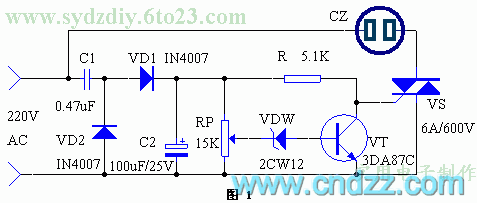Overvoltage protector circuit for home appliances
Source:hdzjd
Related Component PDF Download:
3DA87C
Appliance Overvoltage Protector | ||||||||||||||||||||||||||||||||||||||||
| When the voltage of the power grid suddenly rises for some reason, the running household appliances such as refrigerators, washing machines, TV sets, audio systems, computers and so on will be damaged to varying degrees, and when serious, fires will also occur, which will cause great economic losses. This paper introduces a simple overvoltage protection device. Once the voltage exceeds the allowable range, the power can be automatically cut off, the voltage can be restored to normal and automatically connected, which plays a protective role on home appliances. - How it works  The working principle of the device is shown in Fig.1 (Fig.Click to download the schematic). Capacitor C1 uses diode VD1, VD2 rectifier and capacitor C2 as filters after limiting 220V AC power supply voltage to get 12V or so DC voltage. When the power grid voltage is normal, the voltage regulator diode VDW cannot be broken through, and the triode VT is in the cut-off state. The bi-directional thyristor VS is connected by the voltage trigger surface, and the electrical appliances inserted in the socket XS work. If the voltage of the power grid suddenly rises above 250V, at this point the voltage at the RP midpoint will lead to VDW breakdown conduction. After VDW conduction, the triode VT will also be conducting. After VT conduction, the voltage drop of the collector-emitter is too small to trigger VS, which will cause VS to shut down. Therefore, the household appliances in the socket XS will stop working, thus playing a protective role. Once the voltage of the power network decreases, the VT cuts off again, the collector potential of the VT increases, which triggers the VS conduction, and the home appliances'power supply continues to work. Component selection and fabrication The list of components is shown in the table below.
The debugging of this device is very simple. When the voltage of the power network is 220 V, adjust RP so that VDW does not break down. When the voltage rises to 250V, the saturated conduction of VT is sufficient. It is more convenient to use a voltage-regulating transformer to simulate the changes of power supply during debugging. |
Related Readings
NRF902 FSK 868 MHz transmitter
 2024-03-31 08:00:00
2024-03-31 08:00:00
NRF402 FSK 433 MHz transmitter
 2024-03-31 06:00:00
2024-03-31 06:00:00
NRF904 FSK 915 MHz transmitter
 2024-03-31 04:00:00
2024-03-31 04:00:00
RfHCS362G/362F ASK/FSK 440 ~ 310 MHz KEELOQ code hopping transmitter
 2024-03-31 02:00:00
2024-03-31 02:00:00
RF2942 I/Q 915 MHz transmitter
 2024-03-31 00:00:00
2024-03-31 00:00:00
Popular Circuit Diagrams
NRF902 FSK 868 MHz transmitter
NRF402 FSK 433 MHz transmitter
NRF904 FSK 915 MHz transmitter
RfHCS362G/362F ASK/FSK 440 ~ 310 MHz KEELOQ code hopping transmitter
RF2942 I/Q 915 MHz transmitter
RfPICl2F675H/F/K ASK/FSK 915/433/315 MHz transmitter
RfPICl2C509AG/509AF ASK/FSK 480 ~ 310 MHz transmitter with 8-bit microcontroller
QFMTl-916.5/868/433.92 AM/FM transmitter module
QFMT6-915/869.85/868.4 FM transmitter module
RF2909 GMSK/QPSK/DQPSK/QAM 915 MHz transmitter
Special Sale

